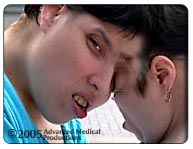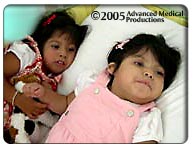Conjoined at the Head explores the life and death
challenges faced by craniopagus conjoined twins
or those connected at the head. Craniopagus conjoined
twins are the rarest and possibly the most difficult
to separate. We examine three such sets of twins
whose lives unfold in three very different ways.
 At
43, Lori and Dori Schappell from Reading, PA are
the oldest living female conjoined twins in the
world. They have lived their lives conjoined at
the side of their heads facing opposite directions.
Surgery has never been a viable option for them
-- they share blood circulation and brain tissue.
In spite of their difficult living arrangements,
Lori and Dori have made the best of the situation
and have no desire to be separated. For the past
eight years, Dori has called herself “Reba”
and has pursued a career as a country music singer.
She has produced a CD and one of her songs is currently
being used in a movie. She holds meetings, makes
appearances and works on her craft. Her twin Lori
makes it clear that she is not part of Reba’s
act. Although she must be physically present, Lori
zones it all out and has a life and ambitions of
her own. Lori and Dori have a positive outlook on
life and view being conjoined as the way God intended
them to be.
At
43, Lori and Dori Schappell from Reading, PA are
the oldest living female conjoined twins in the
world. They have lived their lives conjoined at
the side of their heads facing opposite directions.
Surgery has never been a viable option for them
-- they share blood circulation and brain tissue.
In spite of their difficult living arrangements,
Lori and Dori have made the best of the situation
and have no desire to be separated. For the past
eight years, Dori has called herself “Reba”
and has pursued a career as a country music singer.
She has produced a CD and one of her songs is currently
being used in a movie. She holds meetings, makes
appearances and works on her craft. Her twin Lori
makes it clear that she is not part of Reba’s
act. Although she must be physically present, Lori
zones it all out and has a life and ambitions of
her own. Lori and Dori have a positive outlook on
life and view being conjoined as the way God intended
them to be.
While Lori and Dori have accepted their condition
and found independence even though they are conjoined,
Laden and Lahel Bijani from Iran have a different
story to tell. Despite the daunting difficulties
of being fused at the side of the head, the 29-year-old
Iranian sisters managed to complete law school.
However, as they continued to grow in different
directions as individuals, the sisters found the
limitations of their condition unbearable. So unbearable
in fact, they were willing to undergo a dangerous
separation surgery that eventually ended their lives.
A team of surgeons from around the world, using
the latest computer guided imagery, worked for over
50 hours in hopes of giving the women their ultimate
dream of separate lives. During the operation, surgeons
were unable to control the bleeding and the twins
both died.
 We
learn that separation surgery for infants is much
more common and safer than such a surgery on adults.
Teresita and Josie Alvarez from Guatemala were born
joined at the top of their heads facing opposite
directions in 2001. They were just one year-old
when a team of 50 people successfully separated
them in a 22-hour surgery at Mattel's Children's
Hospital at UCLA. After the procedure, Teresita
developed bleeding in the brain and subsequently
could not drain cerebral spinal fluid through the
veins in the base of her head. After the twins return
to Guatemala, Teresita contracted E. Coli meningitis,
causing anatomical damage to her brain. The girls
are now 3-years-old and reside with foster families
in the US while they receive medical care. Despite
her condition, Teresita is showing daily improvements.
Her sister Josie’s is now the stronger twin
and she is able to lead a more active life than
her sister. We follow the girls through intensive
physical therapy…and many doctor visits as
they work to lead separate lives.
We
learn that separation surgery for infants is much
more common and safer than such a surgery on adults.
Teresita and Josie Alvarez from Guatemala were born
joined at the top of their heads facing opposite
directions in 2001. They were just one year-old
when a team of 50 people successfully separated
them in a 22-hour surgery at Mattel's Children's
Hospital at UCLA. After the procedure, Teresita
developed bleeding in the brain and subsequently
could not drain cerebral spinal fluid through the
veins in the base of her head. After the twins return
to Guatemala, Teresita contracted E. Coli meningitis,
causing anatomical damage to her brain. The girls
are now 3-years-old and reside with foster families
in the US while they receive medical care. Despite
her condition, Teresita is showing daily improvements.
Her sister Josie’s is now the stronger twin
and she is able to lead a more active life than
her sister. We follow the girls through intensive
physical therapy…and many doctor visits as
they work to lead separate lives.